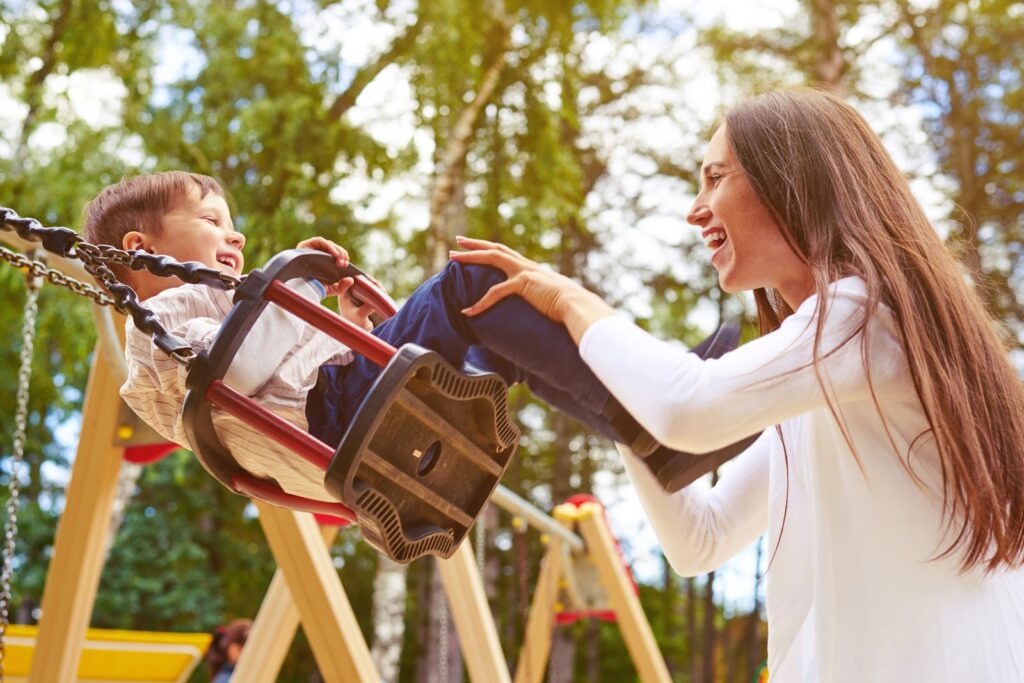Which areas of the UK have the safest public play areas?

happy mother pushing laughing son on swing in a park
In the UK, one in eight children live in households with no gardens. As a result, many families rely on safe public play areas for outdoor exercise and activities within their local communities.
Recent research has also shown that outdoor play has huge benefits for children’s physical health, mental health and emotional well-being.
However, new FOI requests, conducted by Aggregate Industries, the UK’s leading manufacturer and supplier of sustainable construction and building materials, who also are actively involved in the support and build of playgrounds across the country, show that almost 800 playgrounds have closed over the last ten years.
This new data shows a total of 793 playgrounds have been closed in the UK over the last ten years. It also revealed that there have been 28,734 reports of vandalism and 2,786 injuries in play parks across the UK over the last five years.
The latest data comes after a separate series of freedom of information requests revealed local authorities shut 214 playgrounds in financial years 2014-16, blaming ‘unprecedented budget constraints’.
Reflecting on the recent insights, Kirstin McCarthy, Director of Sustainability of Aggregate Industries, said: “We know that playgrounds and access to them are an essential provision for young families – not only for physical wellbeing but also mental and emotional wellbeing too.
“We understand budgets are tight and funding to local governments is squeezed but naturally to see the closure of so many playgrounds is still surprising.
“Supporting the development of local communities is one of the key goals for Aggregate Industries and our sites actively contribute to the social and economic well-being of surrounding communities.
“We have worked in partnership with our local stakeholders providing specialist surfacing, concrete and aggregates for local playgrounds, skateparks and schools and see the huge positive difference it can make.
“We want to do what we can to ensure access to good facilities isn’t a postcode lottery. Every child deserves to play.”
The key statistics: The regions that lost the most playparks
Aggregate Industries’ research showed that Scotland has closed the most play parks over the last decade. A total of 312 parks were closed north of the border, while the South East and East of England also closed 103 and 65 parks respectively.
The key statistics: the most reports of vandalism
As mentioned earlier in this article, a key area factor for families wanting to take their children to a playpark is that it is a safe environment.
However, with data showing there have been 28,734 reports of vandalism in UK play parks over the last five years, there is a wider issue beyond just parks disappearing across local communities.
In April 2022, Syston Town Council reported that a wave of ‘petty and mindless’ vandalism was threatening the future of its playparks, citing a series of destructive acts recently, ranging from play areas’ surfaces being damaged as well as bins and fences being smashed.
They are also one of many councils that said it was struggling with finding drugs paraphernalia and broken glass in public places while noting there was a ‘noticeable’ rise in anti-social-behaviour during the school holidays.
Aggregate Industries’ freedom of information requests shows that Bedford Borough Council received more vandalism reports than any other local authority by a distance in the last five years. Meanwhile, Dudley Metropolitan Borough and Portsmouth City Council each received more than 1,000 complaints during that time.
The key statistics: the most reports of injuries
With vandalism being such an issue across the UK’s local playparks, it is no surprise that it has led to injuries.
London Borough of Hackney revealed that it had 529 reports of injuries on its playparks over the last five years. London Borough of Greenwich also featured in the top three local authorities to have dealt with the most injuries.
Analysis
There are several factors to consider as to why so many playparks have been closed over the last decade.
Children’s playparks are closing down due to budget cuts, maintenance costs, and safety concerns. Many cities and towns are facing monetary constraints, and maintaining playgrounds has become an unaffordable expense. Additionally, playgrounds can be dangerous if they are not properly maintained, and the cost of keeping up with safety standards can be too high for some local governments.
Back in 2020, The Association of Play Industries (API) launched its #PlayMustStay campaign, which showed there had been a 44 per cent decrease in spending on public play areas since 2017 as local authorities across the UK were forced to make difficult decisions about where and how they best spend their budgets.
Recurring vandalism has also proven a significant issue in children’s playparks and not in one isolated location. A quick Google search highlights that vandalism, including damaging expensive equipment worth thousands of pounds, setting fires, and graffiti, is not only making playparks dangerous for families but is also resulting in huge repair bills for councils.
Psychologist on the importance of outdoor play
Reviewing the data, Dr Helen Dodd, a Professor of Child Psychology at The University of Exeter said: “Outdoor play provides opportunities in terms of exploring different emotions, feelings and movements with your body and your mind.
“It’s about playing with excitement, thrill and fear. Our research proposes that having those opportunities helps to prevent mental health problems in children, particularly anxiety and depression.”
“It’s problematic if children don’t have a place to go to play that’s safe. Playgrounds have a very important role, as they are the number one place for children to play when they’re not home.
“If we take them away, we remove opportunities, and as a result what we get are children who stay indoors more, who are less physically active, who get less vitamin D, and are missing out on those opportunities to learn about uncertainty, risk, challenge and things they might experiment with at playgrounds.
“They’re also missing out on opportunities to make new friends, socialise and feel connected with other people in their area.”
What parents had to say
Steve, a 33-year-old dad from Sheffield, explained how he feels trepidation every time he visits his local playground: “My twin boys love being outside, so our local park is usually guaranteed a visit at least once a week, but it’s always a coin-toss as to what state we’ll find it in.
“Broken glass, dog mess and litter are always issues, but sometimes the play equipment itself is damaged or broken completely – and there’s nothing worse than trying to explain to two three-year-olds why they can’t play on a busted swing.”
Sara is from Ilkley and used to often visit her local playground with her 6-year-old daughter. Lately, she’s found it difficult to access the right kind of facilities for her daughter: “Our local playground only really has equipment suitable for younger children and, now that my daughter is almost 7, there is hardly anything she can play with.
“Not to mention that the equipment that is there is falling apart and hasn’t been replaced in years. If we want to visit a playground suitable for her age we have to drive, which defeats the point.
“Playgrounds are a real godsend for parents and outdoor play is so important for children’s development and mental well-being. At a time when parents and children are struggling with their mental health, not to mention the rising cost of living, playgrounds should be considered a priority by councils as they tick so many boxes.”
Similarly, Stuart from Nottingham shared his experience with taking his 3-year-old daughter to the parks closest to him: “There are a few parks within walking distance from where we live. However, someone set fire to one of them recently, and there’s also constant graffiti.
“It means you have to be careful what your kids play on – my daughter’s clothes get covered in soot if we’re not always careful, and she’s often exposed to graphic graffiti. One of the other parks is very poorly maintained – there are no swings or slides anymore, and it’s only really good for taking her to run around or push her scooter.
“During the pandemic, play parks were the only place we could go with her outside and they were seemingly never maintained during that period since they were constantly covered in litter.
“It feels like, with massive budget cuts for local authorities over the last decade, play parks just aren’t prioritised as much as they should be. Play is vitally important for children to learn about themselves, the world around them and their place in it.”




